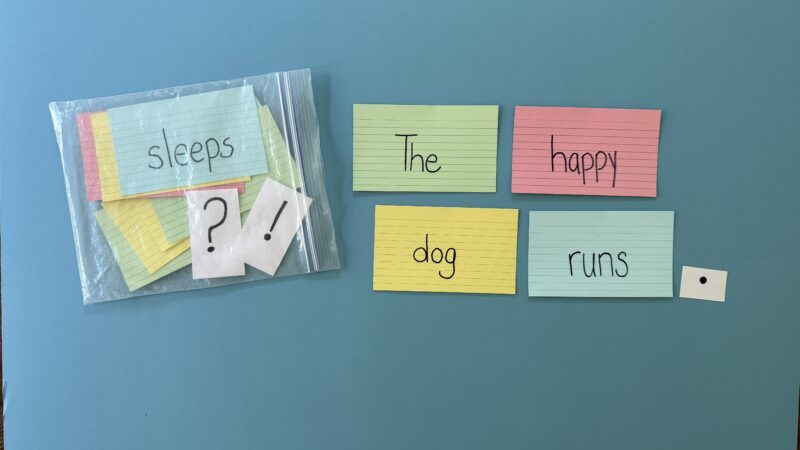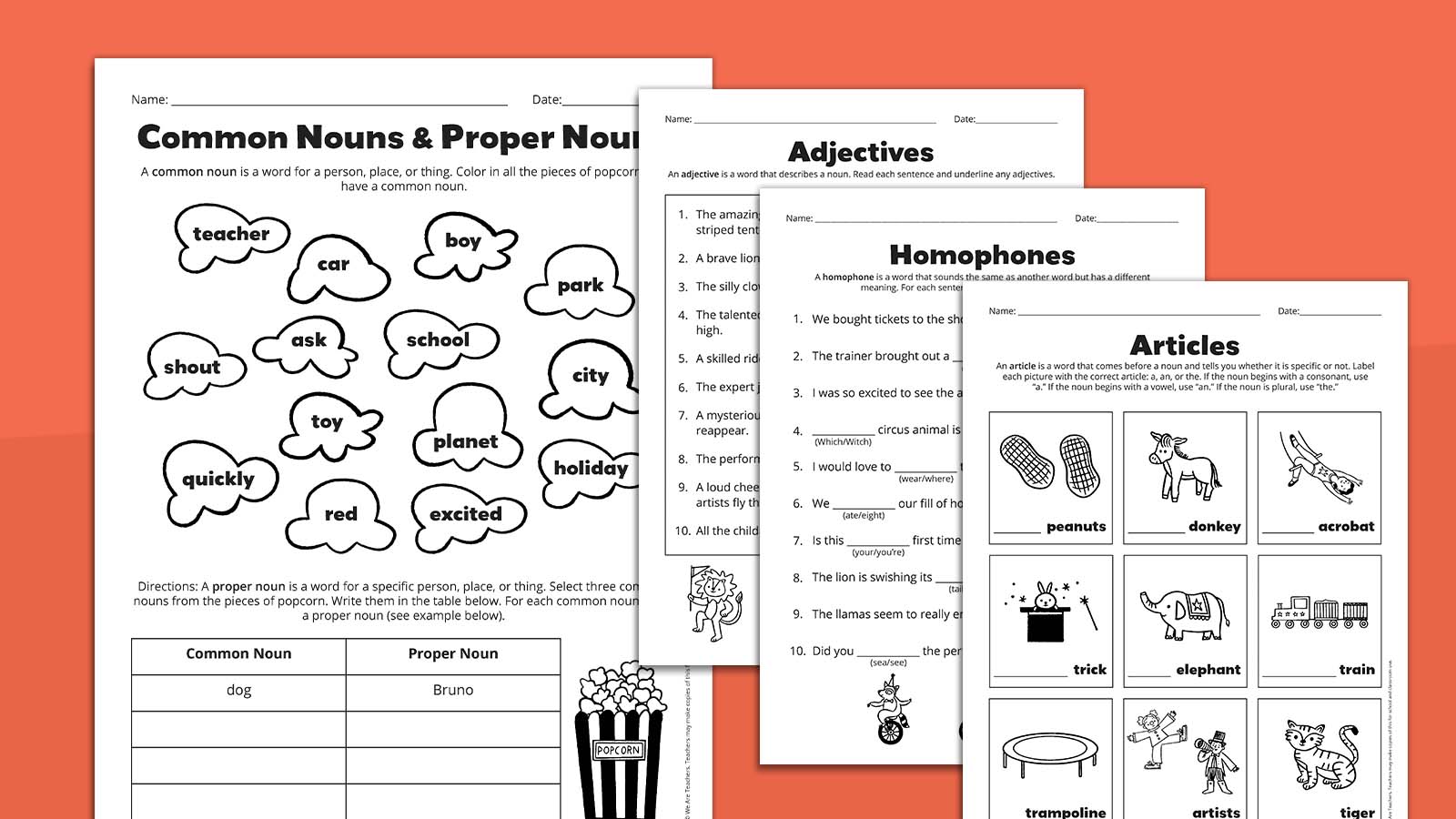
30 Grammar Games for Kids That Make Learning Fun
Teaching grammar can be loads of fun! There are so many active, hands-on ways to engage your learners while at the same time reinforcing important concepts. Here’s a list of our favorite grammar games for kids, with both hands-on and online options.
Jump to:
Hands-On Grammar Games for Kids
It’s true that grammar terms and concepts aren’t necessarily the most exciting language arts concepts for most people. But understanding how language works makes us all better writers. These hands-on grammatical games help reinforce key concepts like parts of speech, syntax, capitalization, punctuation, and more. Plus, kids will really enjoy playing them!
1. Sentence Mix-Up

Materials:
- Colored index cards
- Marker
- Scissors
- Plastic zipper bags
Prep:
- Assign a note card color to various parts of speech and punctuation (e.g., yellow = nouns, blue = verbs, pink = adjectives, white = punctuation, etc.).
- Write a word or punctuation mark on each card according to the colors.
- Mix up the cards and add a few from each category into each plastic zipper bag.
How to play:
- Divide students into pairs and give each pair a bag of word cards.
- Students take turns using the words and punctuation cards in the bag to create sentences, writing them down on a piece of paper.
- The goal is to make as many unique sentences as possible. The game ends when they’re unable to come up with any new sentences. The student who creates the most sentences wins.
2. Punctuation Out Loud
Materials:
Prep:
How to play:
- Start your story time read-aloud, but as you read, say the punctuation at the end of the sentences out loud. For instance, “The boy and his dog went to the park period. They were excited to see a party going on exclamation point!”
- After a few pages, begin pausing at the end of each sentence to see if students can guess which punctuation mark comes next. Be sure to read with proper inflection to give kids vocal cues.
- If you’d like to turn this activity into a true game, have students take turns and award points for correct answers.
3. Punctuation Scavenger Hunt
Materials:
- A selection of picture books
- Paper and pencils
Prep:
How to play:
- Break students into pairs, and ask each pair to choose one book from the pile.
- Each pair looks through their book together, counting and keeping track of the number of various types of punctuation they find—periods, question marks, exclamation points, commas, etc.
- When all teams are finished, compare their results. Ask kids to think about what the punctuation counts might be able to tell them about each book (if anything).
4. LEGO Sentences

Materials:
- LEGO bricks in a variety of colors
- Masking tape
- Marker
- Small plastic cups
Prep:
- Attach a small piece of masking tape to the side of each LEGO brick, and write a word on each. Color-code your words, e.g., yellow for nouns, blue for verbs, green for articles, red for adjectives.
- Pour all the LEGO bricks into a bin and mix them up.
How to play:
- Give each player a cup and let them scoop up some LEGO bricks.
- Set a timer for one minute (or longer as needed). Players dump out their bricks and try to make the longest sentence they can using the words they have. They must use at least one brick from each color/word category that’s in their cup.
- When the time is up, students read out their sentences and receive one point per word. Write down the totals and dump all the bricks back into the bin.
- Mix up the bin and play another round. Continue as long as you like—the player with the most points is the winner.
5. “Cap”-ital Letters
Materials:
- Read-aloud books
- Newspaper sheets
Prep:
How to play:
- Help students make paper caps. (Optional: Decorate the caps with capital letters.)
- Start your read-aloud. First, read a sentence at a normal speed. Then, read the sentence word by word, pausing between each.
- When kids hear a word that should be capitalized, they pop on their caps. (Example: For the sentence “I went to see Aiden and Quinn in Arizona,” kids put on their caps four times.) They take off their caps (or leave them off) for lowercase words.
6. Punctuation Stickers

Materials:
- Sheets of colored dot stickers (one per student or pair)
- Markers
- Sentences for dictation
- Paper and pencils
Prep:
How to play:
- First, assign a color to each type of punctuation you plan to use (e.g., yellow for periods, green for question marks, pink for commas, red for apostrophes, etc.).
- Have students write these punctuation marks on the appropriate stickers on their sheets.
- Now, dictate a sentence for students to write on their paper. Have them use the colored stickers to add the appropriate punctuation.
- Ask one student to share their sentence, and decide as a class if their punctuation is correct. Make any changes needed.
- Repeat with as many sentences as you like.
7. Parts of Speech Hopscotch

Materials:
- Sidewalk chalk
- Stones or markers
Prep:
- Draw a typical hopscotch frame outside on the playground or sidewalk.
- Instead of numbering the squares, label them with parts of speech like noun, pronoun, verb, adjective, adverb, conjunction, preposition, prepositional phrase, and interjection.
How to play:
- The player tosses a stone or marker onto the hopscotch frame and hops to the square it lands on.
- Once they get there, they have 10 seconds to say a word that fits the part of speech. (For example, if they land on adverb, they might say “sadly” or “quickly.”)
- If the player is able to name a word, they receive a point.
- Play as long as you like. The player who earns the most points wins.
8. Contraction Surgery

Materials:
- Index cards
- Paper clips
- Markers
- Scissors
- Band-Aids or masking tape cut into small pieces
Prep:
- Choose two words that can be used to make a contraction, and write one on each of a pair of index cards. Clip them together with a paper clip.
- Make as many sets as you like. Example word pairs: I/Am, We/Are, You/Are, It/Is, Did/Not, Were/Not, Had/Not, Has/Not.
How to play:
- Give each student a few sets of card pairs, scissors, and some Band-Aids, and tell them they are now Contraction Surgeons!
- Their job is to cut up each card in a pair and use Band-Aids to stick it back together to form a contraction. Use the marker to add the apostrophe to the Band-Aid if needed.
- For instance, if they have DID and NOT, they would need to cut up the NOT card into individual letters. Then, they would attach the N to DID, and the T to the N. Then, they’d write an apostrophe on the Band-Aid connecting the T and N.
- When they’re done, have them trade cards with a friend to check their answers.
9. Mad Libs
Materials:
- Mad Libs books or worksheets (buy or create your own)
- Pencils
Prep:
How to play:
- Divide students into teams of three or four.
- Display the blank list. Ask teams to number a piece of paper, then fill in the list with the right types of words.
- Pass out or display the Mad Lib story. Have each team share their completed stories—they’ll giggle at the results!
10. Homophone Pictionary

Materials:
- Paper
- Paper and markers (or individual whiteboards)
- Whiteboard and dry-erase markers
- Timer
Prep:
- Write sets of homophones on index cards (e.g., deer/dear, sea/see, ate/eight). Mix up the cards and place them face down.
How to play:
- Divide the class into two teams. Flip to see who goes first, and ask the team to choose their first player.
- The player comes to the front of the room and chooses a card but does not show it to anyone.
- The player has two minutes to draw the homophones that are on their card on the whiteboard. Their team must try to guess the words, writing down both correct spellings on their paper or individual whiteboard.
- If the team gets it right before the two minutes are up, they’re awarded a point.
- If they’re wrong, the other team can steal the point by writing both words correctly.
- The next team chooses a player and the game continues. Play as many rounds as you like. The team with the most points wins.
11. Pasta Commas

Materials:
- Sentence strips
- Markers
- Elbow macaroni
Prep:
- Write sentences that need multiple commas on the strips, leaving out the necessary commas.
How to play:
- Give each student (or team of students) a sentence strip and a handful of macaroni.
- Students place the macaroni “commas” along the strips where they belong.
- Check the answers, and give the student or team a point for each correct comma. Take away a point for any comma that isn’t needed or is in the wrong place.
- Rotate the sentence strips by having kids pass them to a new student or pair. Repeat the game with the new sentences. Score the results and continue.
- Continue until every student or team has marked each sentence. The student or team with the most points wins.
12. Parts of Speech Ball Toss
Materials:
- Inflatable beach ball
- Permanent marker
- Pencils and paper
Prep:
- Blow up the ball. Write the parts of speech (noun, pronoun, verb, conjunction, adjective, adverb, preposition, interjection) scattered around the ball.
How to play:
- Students stand in a circle to play this game.
- Toss the ball to the first student. Ask them to look at the part of speech that their right thumb is on (or is closest). They must name a word that fits that part of speech, then use it in a sentence.
- Example: A student’s thumb lands on adverb. They might say “loudly,” and use it in a sentence: “The crowd cheered loudly when their team scored.”
- Continue until everyone has had a turn.
- Variation: For a real challenge, ask the first player to start a story with their sentence, writing it on the board. Each student must continue the story with their sentence, adding it to the board as they go.
13. Roll a Sentence
Materials:
- Dice
- Paper and pencils, or dry-erase board and markers
Prep:
- Create a list of six parts of speech, punctuation marks, or grammatical clauses you want students to practice. An example could be:
- 1 = An adjective and an adverb
- 2 = A semicolon
- 3 = A prepositional clause
- 4 = Quotation marks
- 5 = Participial phrase
- 6 = No articles (a, an, the)
How to play:
- Break students into pairs or teams. Give each a die.
- Players take turns rolling the die and writing a correct sentence using at least one noun and verb, plus whatever is required by their roll.
- Example: The player rolls a 2 (semicolon). They write: It was a hot day; I was happy to spend it at the beach.
- Optional: Up the challenge by having kids roll two dice and incorporating both requirements into their sentence.
- Example: The player rolls a 4 and a 6 (quotation marks and no articles). They write: “I like pizza,” said Ali.
14. Grammar Taboo
Materials:
- Index cards
- Markers
- Timer
Prep:
- Make two sets of parts of speech cards, with one part of speech written on each.
How to play:
- Divide the class into two teams and give one set of cards to each team. Teams shuffle their cards and place them face down.
- The first team chooses a player to start. The player picks up the first card but doesn’t look at it. Instead they hold it on their forehead for their teammates to see.
- Start the timer for 60 seconds. The players’ teammates give examples of the part of speech, trying to get the player to guess the correct part. If they get it in time, they get a point. If not, the other team has one chance to steal the point.
- Take turns until each team has been through all of their cards. The team with the most points wins.
15. Contraction Bingo
Materials:
- Contraction bingo cards
- Markers
- List of expanded contractions
Prep:
- Use a bingo card generator to make contraction bingo cards, and print enough versions for each member of the class to have one.
How to play:
- Give each player a bingo card and markers.
- Call out an expanded contraction, such as “I am.” Players mark the spot “I’m” on their cards, wherever it’s located.
- Continue until one student gets a row across, down, or diagonally. The first to do so wins the round. Then, clear the markers, trade cards (if you want), and start again.
16. Grandmother’s Cat
Materials:
Prep:
How to play:
- Players sit or stand in a circle.
- The first player says, “My grandmother’s cat is ______.” They should fill in the blank with an adjective that starts with A, such as “My grandmother’s cat is agile.”
- The next player continues, adding to the list with an adjective that starts with B. “My grandmother’s cat is agile and big.”
- Continue until everyone has had a turn. Kids can help each other out in remembering the words, and you can skip tricky letters like X if needed.
- Variation: Get some verb practice by changing the sentence to “My grandmother’s cat likes to _____.” Example: “My grandmother’s cat likes to add, bite, color, draw, etc.”
17. Sentence Smackdown
Materials:
- 2 flyswatters
- Whiteboard and markers
Prep:
- Write a list of simple sentences and sentences fragments on the whiteboard. Mix them up and/or space them out around the board.
How to play:
- Divide the class into teams, and give each team a flyswatter. Have them line up in two lines facing the board and choose their first player.
- Start the game by calling out “simple sentence” or “sentence fragment.” The first players from each team race up to the board and try to be the first to swat whichever sentence type is called out.
- If the first player is correct, award the team a point and erase that sentence or fragment from the board.
- If they were not right, award a point to the other player if they were correct, and erase that sentence or fragment. Otherwise, no team gets a point.
- Repeat until the board is empty. The team with the most points wins the game.
18. Noun Hunt

Materials:
Prep:
- Make enough copies of the scavenger hunt page for each student or team to have one.
How to play:
- Remind students that a noun is a person, place, or thing. Pass out the scavenger hunt worksheets.
- Set a timer for 15 minutes. Students look around the classroom and try to find nouns (people, places, or things) that fit each letter of the alphabet, writing them on the worksheet. For example:
- A = Artwork
- B = Books
- C = Children
- Read off the lists when the time is up, and give kids one point for each noun they find.
19. Grammar Simon Says
Materials:
Prep:
- Establish a list of motions for different parts of speech. (Examples: noun = raise your right hand, verb = touch your nose, adjective = hands on head, etc.)
- Write the list on the board in a place where it can be hidden.
How to play:
- Share the list of motions with your class. For the first round, leave the list up while you play.
- Say, “Simon says: [word].” Kids identify the part of speech and do the appropriate motion. (e.g., “Simon Says: tall.” Kids put their hands on their head.)
- Players who get the motion wrong are out.
- Players who move when you don’t start with “Simon Says” are also out.
- After a few minutes, up the difficulty by hiding the list of motions on the board. Now players have to remember the right motion as well as identifying the part of speech and listening for Simon Says. Last one standing wins.
20. Parts of Speech Go Fish
Materials:
Prep:
- Make a big set of word cards by writing individual words on each index card. Include a mix of the various parts of speech. (You can also use premade sight word cards or something similar.)
How to play:
- Divide kids into groups of four or five. Give each group a stack of cards.
- One player shuffles the cards and deals them face down so each player has five cards.
- Lay the rest of the cards in a face-down stack in the middle.
- Players look at their hands and see if they can make a set of three of any parts of speech. If so, they can lay these cards down face up in front of them. (For example, if a player has the words “sun, and, chicken, jump, ball,” they can lay down “sun, chicken, ball.”)
- The player to the right of the dealer starts. They ask the player to their right for a type of card, such as: “Do you have any conjunctions?”
- The second player gives them any conjunctions in their hand, or says “Go fish.” The first player draws a card from the pile in the middle.
- If the first player can now lay down a set of three, they do it. Then their turn ends.
- Play continues until one player has laid down all their cards in sets, winning the game.
Online Grammar Games
21. Beech Jeep Plural Endings
Drive along looking for the correct plural ending of the words shown. When you find them, smash them with your “Jeep Punch.”
Learn more: Beach Jeep at RoomRecess.com
22. Irregular Plural Nouns Ski Race
This lively game will challenge your students’ understanding of irregular plural nouns such as mice, feet, and geese. Students must find the plural noun of each word in order to help their ski racer make it down the mountain first.
Learn more: Ski Race: Irregular Plural Nouns at Education.com
23. Sentence Monkey
This game helps students practice putting simple words in the present tense together to form sentences. It’s especially helpful for English language learners.
Learn more: Online Sentence Monkey at ESL Games+
24. English Grammar Help
This free, fun, self-paced site offers a variety of grammar games, from parts of speech to punctuation and more.
Learn more: Online Grammar Games at English Grammar Help
25. Apostrophe Grammar Game
This undersea game helps students practice the valuable skill of placing apostrophes in possessive nouns.
Learn more: Placing Apostrophes in Possessives at Education.com
26. Furious Frogs
Colorful frogs compete for bugs while practicing antonyms, synonyms, and homonyms. Can you catch the most bugs and win the game?
Learn more: Furious Frogs at Word Game Time
27. Adjective Order Game
In this very simple game, players are given a set of words that make up a phrase including more than one adjective. They must put the words into the correct order (e.g., “clear a sky blue” = “a clear blue sky”). This game is very basic, but it’s an excellent way to practice this skill that is especially tricky for those learning English as a foreign language.
Learn more: Adjective Order Game at English Club
28. Adjectives and Opposites Pirates
Identify the adjectives and their opposites (antonyms), but watch out for the tricky pirates! This site has multiple online grammar games using this same theme.
Learn more: Adjectives and Opposites Pirates at ESL Games World
29. Parts of Speech Invasion
As the jellyfish drift in, the octopus must shoot them with the correct legs (each labeled with a different part of speech) to keep from getting stung.
Learn more: Parts of Speech Invasion at Word Game Time
30. Prepositions Match
The game is simple: Move the prepositions into the right place to complete sentences that match the scene.
Learn more: Prepositions Match at Games To Learn English
Don’t forget to grab your free printable grammar worksheets for grades 2 and 3!

If you like these grammar games for kids, check out Meaningful Vocabulary Activities for Every Grade.
Plus, find out how other teachers tackle grammar practice in the We Are Teachers HELPLINE group on Facebook!
Source link




